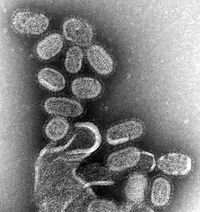
Photo from wikipedia
Abstract Background Influenza is known to be associated with various neurological complications, including encephalitis. We conducted a registry-based study to assess the risk of encephalitis after influenza and A(H1N1)pdm09 vaccine.… Click to show full abstract
Abstract Background Influenza is known to be associated with various neurological complications, including encephalitis. We conducted a registry-based study to assess the risk of encephalitis after influenza and A(H1N1)pdm09 vaccine. Methods Data from Norwegian national health registries during 2008–14 were linked using the unique personal identifiers given to all Norwegian residents (N = 5 210 519). Cox proportional-hazard models with time-varying variables were fitted to estimate hazard ratios (HRs) of encephalitis after influenza and A(H1N1)pdm09 vaccine, using the risk windows 0–7, 0–14, 0–30, 0–60, 0–90 and 0–180 days. Results In Norway, 684 172 individuals received an influenza diagnosis and 2793 patients were hospitalized with encephalitis during 2008–14. The risk of encephalitis increased after influenza: HR, 7-day risk window: 47.8 (95% confidence interval (CI): 35.8–63.8), and the HR decreased for longer risk windows; HR, 180-day risk window: 3.8 (95% CI: 3.1–4.7). HR of encephalitis after influenza during the 2009 main pandemic wave using a 7-day risk window was 30.0 (95% CI: 10.8–83.2). We found no differences in the risk of encephalitis after the seasonal influenza compared with influenza during the 2009 main pandemic wave; HR, 7-day risk window: 1.3 (95% CI: 0.4–4.3). A(H1N1)pdm09 vaccine was not associated with the risk of encephalitis: HR, 14-day risk window: 0.6 (95% CI: 0.2–2.1). Conclusions There was an increased risk of encephalitis following influenza but not after A(H1N1)pdm09 vaccine. The risk of encephalitis was highest in the first few weeks after influenza.
Journal Title: International Journal of Epidemiology
Year Published: 2017
Link to full text (if available)
Share on Social Media: Sign Up to like & get
recommendations!